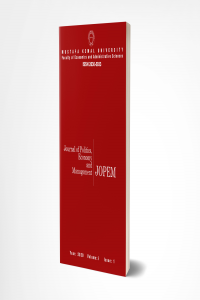What really matters? A triumph of brand extension: Evidence from Engro Corporation
What really matters? A triumph of brand extension: Evidence from Engro Corporation
The intent of this study is twofold; firstly, to find out the different elements of the brand extension in different category product that influences it, secondly, evaluate the impact of these dimensions on brand extension. The study considered Engro as parent brand. The targeted brand was Engro Foods. A total of two hundred valid responses were collected from Lahore and Sahiwal through a self-administered survey. Reliability was tested by using Cronbach’s alpha. The study used descriptive statistics; correlation analysis and regression analysis. Correlation results indicate that all variables; similarity, perceived risk, brand reputation, and innovativeness were positively correlated with evaluation of brand extensions. However, “brand reputation” was strongly correlated with the evaluation of extensions as compared to other variables. As far as regression analysis is concerned adjusted R2 indicates that 48.0% of “Engro” extension was affected by the independent variable. The mean score highlighted that “Engro extension” was positively evaluated by customers and have a positive attitude towards them on all the variables. The study showed due to the strong reputation of parent brand, the Engro unrelated category extension “Engro Foods” was more favorably evaluated by customers.
Keywords:
Brand Extension, brand reputation, perceived risk,
___
- Aaker, D.A., & Keller, K.L. (1990) Consumer evaluations of brand extensions. Journal of Marketing, 54(1), 27-41.
- Afzal, S. (2013). Factors influencing successful brand extension into related and unrelated product categories. Asian Economic and Financial Review, 3(2), 216-226.
- Barone, M.J., Miyazaki, A.D., & Taylor, K.A. (2000). The influence of cause-related marketing on consumer choice: does one good turn deserve another?. Journal of the Academy of Marketing Science, 28(2), 248-262.
- Bottomley, P., & Doyle, J. (1996). The formation of attitudes towards brand extensions: Testing and generalizing Aaker and Keller's model. International journal of Research and Marketing, 13(4), 365-377.
- Boush, D.M., & Loken, B. (1991). A process-tracing study of brand extension evaluation. Journal of Marketing Research, 28(1), 16-28.
- Boush, D.M., Shipp, S., Loken, B., Gencturk, E., Crockett, S., et al. (1987), Affect generalization to similar and dissimilar brand extensions. Psychology & Marketing, 4(3), 225-237.
- Dacin, P.A., & Smith, D.C. (1994). The effect of brand portfolio characteristics on consumer evaluations of brand extensions. Journal of Marketing Research, 31(2, Special Issue on Brand Management), 229-242.
- de Chernatony, L., Drury, S., & Segal-Horn, S. (2003). Building a services brand: Stages, people and orientations. Service Industries Journal, 23(3), 1-21.
- Derbaix, C. (1983). Perceived risk and risk relievers: An empirical investigation. Journal of economic psychology, 3(1), 19-38.
- Dowling, G. R., & Staelin, R. (1994). A model of perceived risk and intended risk-handling activity. Journal of consumer research, 21(1), 119-134.
- Hem, C. D. (2011). Factors influencing successful brand extensions. Journal of Marketing Management, 19(7-8), 781-806.
- Herr, P.M., Farquhar, P.H., & Fazio, R.H. (1996) Impact of dominance and relatedness on brand extensions. Journal of Consumer Psychology, 5(2), 135-159.
- Keller, K. (1993). Conceptualizing, measuring, and managing customer-based brand equity. Journal of Marketing, 57(1), 1-22.
- Keller, K.L., & Aaker, D.A. (1992). The effect of sequential introduction of brand extensions. Journal of Marketing Research, 29(1), 35-50.
- Khan, M., & Rahman, H. (2009). Factors contributing towards successful brand extension. ASA University Review, 3(2), 1-16.
- Park, W.C. Milberg., S., & Lawson, R. (1991). Evaluation of brand extensions: The role of product feature similarity and brand concept consistency. Journal of Consumer Research, 18(2), 185-193.
- Rogers, E.M. (2003). Diffusion of innovations (Fifth ed.). New York: Free Press.
- Shakeel, M., Dilnawaz, P., Ziyaurrahman, Safura, K., & Chanderprakash, B. (2011). Alternative system of medicine of India: A review. International Research Journal of Pharmacy, 2(4), 29-37.
- Smith, D.C., & Park, C.W. (1992). The effects of brand extensions on market share and advertising efficiency. Journal of Marketing Research, 29(3), 296-313.
- Steenkamp, J.B.E., & Baumgartner, H. (1992). The role of optimum stimulation level in exploratory consumer behavior. Journal of Consumer Research, 19(3), 434-448.
- Sundar, K. S. (2012). Drivers of brand extensions success. International Journal of Multidisciplinary Management Studies, 2(2), 190-203.
- Sunde, L., & Brodie, R.J. (1993). Consumer evaluations of brand extensions: Further empirical results. International Journal of Research in Marketing, 10(1), 47-53.
- Völckner, F., & Sattler, H. (2006). Drivers of brand extension success. Journal of Marketing, 70(2), 18-34.
- ISSN: 2630-5933
- Yayın Aralığı: Yılda 2 Sayı
- Başlangıç: 2018
- Yayıncı: Hatay Mustafa Kemal Üniversitesi
Sayıdaki Diğer Makaleler
İnsani gelişme endeksi ile büyüme ilişkisi: Pedroni eşbütünleşme örneği
What really matters? A triumph of brand extension: Evidence from Engro Corporation
Sara JAVED, Md.salamun RASHIDIN, Wang JIAN
Kamu-özel sektör işbirliğinde risk yönetimi ve Türkiye üzerine bir değerlendirme
Türkiye’de küreselleşme, ekonomik büyüme ve çevre kirliliği ilişkisi
